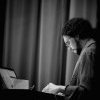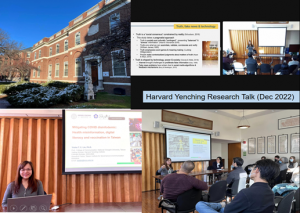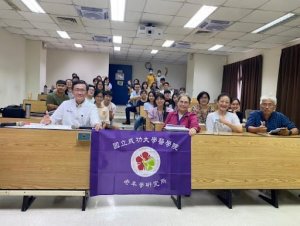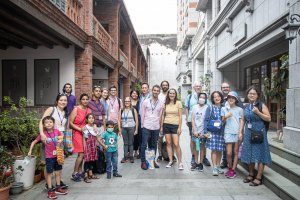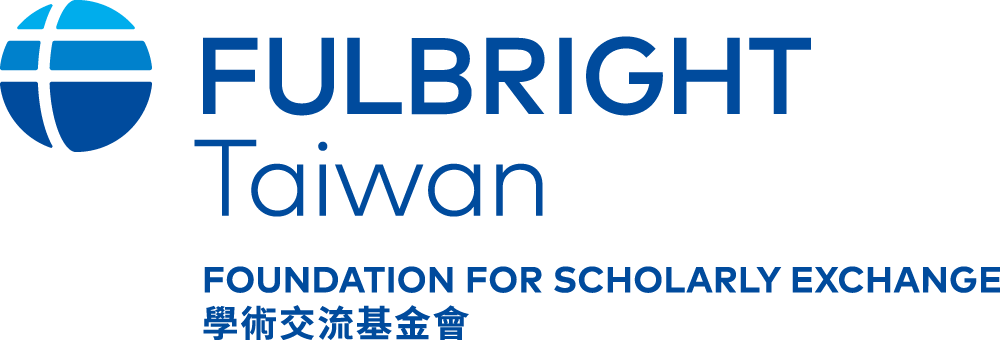Ever since I decided to become a composer, I’ve longed for the opportunity to spend a year abroad and immerse myself in a different culture. I believed that this experience would help me to better understand other cultures as well as my own creative voice. I am thankful that last spring I was awarded a Fulbright Senior Scholar grant to teach and research in Taiwan this academic year. I am also grateful that my home institute, Florida International University (FIU), graciously agreed to support my time abroad.
I have adapted this article from the last of a series of four blog posts on my experiences in Taiwan and Asia that New Music Box, a leading English website that focuses on new music, commissioned me to write. You can read all of the four original posts here.
*
I have been regularly travelling to and learning about the new music scene in Taiwan since I met my wife Chen-Hui Jen nearly nine years ago. Over these years, I’ve been particularly struck by the myriad ways Taiwanese composers express their cultural identity in music and, as I mentioned in a post for New Music Box, by their compositions for Chinese instruments. I also noticed that few local composers compose with electronics. As I use electronics and computers in most of my works and consider them to be one of the most expressive compositional and exciting resources available, I’ve fostered cultural exchanges with the Taiwanese new music community where I could share my knowledge and experiences with technology and, in exchange, learn more about their own Asian musical techniques and philosophy.
In the summer of 2014, I spoke with the composition faculty at National Chiao Tung University—Lee Tzyy-Sheng, Tseng Yu-Chung, and Tung Chao-Ming—and they strongly supported my Fulbright application to teach at their university during the 2015–16 academic year. My proposal was to teach graduate music classes in composition and music technology as well as an undergraduate course on music and technology for non-music majors. In these courses, I proposed to use curriculum that reached across disciplines to encourage greater interaction between students working in different fields. I also applied for a Fulbright in Taiwan because I wanted to engage with the local new music community as well as research traditional and new music for Chinese instruments.
I applied to teach at NCTU because it houses the first and, likely, the most active computer music studio in Taiwan. Also, NCTU has one of Taiwan’s best graduate music programs as well as one of its only interdisciplinary music technology programs. Finally, I applied to teach at NCTU because I was already close to the composition faculty and looked forward to working with them for a year. (N.B. NCTU is usually ranked as the third best research institute in Taiwan, and, in worldwide rankings, its engineering and computer science programs place in the top 50. Because of these rankings, the university is often referred to as the MIT of Taiwan.)
*
This spring, I was asked to teach the graduate composition seminar. While I was planning this course, some of my colleagues mentioned that some previous seminars had focused on the complete works of Alban Berg or Anton Webern. In contrast to this approach, I decided to structure my seminar so that I could present as many different contemporary composers, ideas, and techniques as possible. I did not want to focus on music that’s best understood by tonal or atonal pitch theory or traditional formal analysis that most Taiwanese graduate music seminars concentrate on. After much thinking, I decided to create a seminar that focuses on compositions written after 1945 that are based on research and examination into areas outside those usually explored in Western classical music.
To give the students some resources for the seminar, I prepared a large reference document that includes a list of over 100 composers along with some of their selected important works and their main compositional interests. I also gave the students a topic-based bibliography with over 130 entries. For the seminar, I created a listening list with 34 compositions by 32 different composers as well as a short reading list. For each class, I regularly focused on one or two topics and then presented music and composers whose work related to the topic. For example, some of the topics I covered include just intonation, acoustics, cognition and perception of form, the relation between visual art and music, conceptual and performance art, computer-assisted composition, instrumental techniques, and improvisation.
During the first few classes of this composition seminar, I got the impression that the students were either a bit overwhelmed or not sure what to think when encountering so many new composers and different approaches in each class. However, after week two, I noticed the students getting excited. For example, the classes where I presented Gérard Grisey’s observations on the perception of rhythm and time, Iannis Xenakis’s stochastic approach to composition, as well as the one where I presented some auditory illusions alongside compositions by James Tenney, György Ligeti, and Georg Friedrich Haas that reference or use these illusions generated a lot of discussion that continued even after I left the classroom.
Each semester at NCTU, I directed the student laptop ensemble, Chiao Tung Laptop Orchestra (CLOrk). My goal for the class was to give the members of CLORk a broad background and experience on the many different ways people make music with computers and technology. At NCTU, almost all of the students in CLORk are enrolled in the Sound and Innovative Music Technologies master’s degree program. Students in this program typically have undergraduate degrees in computer science or an engineering program and usually do not have undergraduate degrees in music or much formal music training. Likewise, these students often enter the degree program with little experience playing in ensembles and not much experience using music computer programs or any other form of music technology.
To make up for this deficit, I spent time covering the history of computer music as well as reviewing cables, mixer routing, and rehearsing multiple laptop ensemble works. In the first semester, I demonstrated multiple synthesis techniques and mapping strategies and helped each student develop his or her own external controllers and digital instrument. This semester, I’ve demonstrated many examples of algorithmic composition to help the students develop their own generative computer music instruments. At the end of this semester, each student performed the compositions that they wrote and communicated with every other students’ software instrument so that the class could perform a collectively composed network composition.
Finally, this year I taught an undergraduate course for non-music majors designed to introduce students to electronic and computer music. The students who took the class were majoring in computer science and different engineering programs. Since these are some of the brightest students in Taiwan and all have strong backgrounds in technology, I designed the course to focus on music, history, ideas, and the ways that technology and music have influenced each other since the beginning of the 20th century. My hope was to teach a class where these students would spend more time critically and creatively engaging with ideas than they do in their other courses.
To do this, I asked the students to read and respond to some foundational writings on new music and technology. These readings included essays, lectures, and manifestos by Luigi Russolo, John Cage, Pierre Schaeffer, Karlheinz Stockhausen, R. Murray Shafer, Alvin Lucier, Pauline Oliveros, Jacques Attali, Steve Reich, Brian Eno, Merzbow, and others. I dedicated much class time to playing historically significant as well as more recent electronic and computer music. Compared to instances where I’ve presented similar materials to classes in the USA, I was pleasantly surprised by how receptive and genuinely fascinated many of my Taiwanese students were to the class materials. Although I’ve found it more difficult to engage Taiwanese students in class discussions, there were a number of memorable moments when a few students became rather excited. For example, I remember one early lecture where I played Elektronische Studie II by Stockhausen, Williams Mix by Cage, and Bye Bye Butterfly by Oliveros. At the end of class, three groups of students were each fond of a different piece and were arguing with each other about why they liked one piece more than another. Likewise, there were multiple instances after I presented some more experimental works like Lucier’s I am sitting in a room that reveals hidden resonances of a space, Paul Demarini’s sound sculptures, James Tenney’s hypnotic For Ann (rising), and Ryoji Ikeda’s glitch-based recent works that students admitted that they were genuinely astounded by the music.
Near the end of the course, I asked each student to create an electronic composition based on some of the techniques and ideas that we had discussed in class. In general, I was impressed by how musical and imaginative many of the projects were. In fact, a number of these compositions were as good as the ones my undergraduate music technology students have made in Miami. The results of this creative project in particular have made me consider that I should open the entry-level music technology courses I teach at FIU to non-music students.
*
Beyond my teaching at NCTU, I have been rather active in Taiwan’s new music community during my Fulbright grant year. One of the main music activities I was involved with was the 2015 Taipei International New Music Festival (TINMF). The Taiwan chapter of the International Society of Contemporary Music (ISCM) organizes the festival, which is usually the biggest new music festival in Taiwan. For the last four years, the director of the Taipei ISCM Chapter, Lee Tzyy-Sheng, has been the festival’s Artistic Director. Since I am a co-director of the Miami/Florida International University Chapter of the ISCM, three summers ago, I proposed to Lee that our two chapters collaborate for an upcoming TINMF. My specific proposal was that his festival could feature FIU’s ensemble-in-residence, the Amernet String Quartet, performing—among other American and Asian works—George Crumb’s Black Angels. Lee was very excited about this proposal and, after a couple of years of planning and fundraising, he was able to invite them to the festival while I was in Taiwan as a Fulbright Scholar.
The 2015 TINMF took place from October 16 to 18 and included six concerts and a series of guest lectures in Taipei. This was followed by a demo lecture and concert in Hsinchu. For the festival, Lee decided to focus on new music from the USA and Asia. This was actually a very bold artistic direction as most Taiwanese new music concerts only feature music from Western Europe and Taiwan.
The Amernet String Quartet was the featured guest ensemble for the festival, and for the opening concert on Friday night, they performed three important string quartets by American composers: String Quartet No. 5 by Elliott Carter, String Quartet in Four Parts by John Cage, and Black Angels by George Crumb. As the invited sound engineer for the festival, I amplified Black Angels into four speakers that surrounded the seating in order to immerse the audience in the sound of the quartet as well as present a different approach to live sound diffusion. Lee Tzyy-Sheng programmed two solo guqin works—Flowing Water and Youlan—to begin each half of this concert in order to provide a contrast to the quartet’s repertoire. The second day of the festival featured two concerts of commissioned works by local Taiwanese composers performed by the Ensemble ISCM-Taiwan. The first of these concerts featured works with voice, and the second concert featured unique combinations of Chinese and Western instruments. On Saturday evening, the Amernet performed a second full concert that mostly featured Asian composers. Their program featured Spiral 3 by Chinary Ung, Kalligraphie by Toshio Hosokawa, the Taiwanese premiere of String Quartet No. 3 by Pan Hwang-Long, and the world premiere of my composition Time and After for string quartet and live electronics. This concert also included compositions by young Taiwanese composers Yen-Ning Chiu (邱妍甯) and Chien-Wei Wang (王建為), which the quartet selected from a call for works.
On the last day of the festival, I performed a concert for cello and electronics with the cellist from the Amernet String Quartet, Jason Calloway. Although Jason and I have been performing together for many years, this was our first performance together in Asia, and from what I understand, a rare opportunity for a Taiwanese audience to hear an entire program of music for an instrument and live electronics. For our program, we played Petals by Kaija Saariaho, the highly virtuosic as hovering ashes in a quarter moon by Chen-Hui Jen, and my composition Trefoil Knots (総角). We premiered a work by a young Taiwanese composer, Chi-Ruei Huang (黃麒瑞), that we had selected from a call for scores and Chen-Hui joined us to perform Advaya by Jonathan Harvey. After our duo concert, the finale of the TINMF was a tribute to George Crumb and featured the Ensemble ISCM-Taiwan and the Taiwanese percussion group Ensemble 1002.
Overall, the festival was very well attended and positively received. The audience for the opening concert nearly filled all 471 seats in the hall. Although not as big as the opening concert, the Saturday evening concert and the George Crumb tribute had rather large audiences. Finally, in Hsinchu, the Amernet and I were shocked when our demo lecture and concert each had over 1000 people in attendance.
In late November, NCTU hosted the 2015 International Workshop on Computer Music and Audio Technology (WOCMAT) Conference. To help my colleagues who were organizing the festival and are not very experienced managing the all technical aspects of concerts with live electronics, I volunteered to be the technical director for the conference. In this capacity, I worked with a number of students and hired staff to organize and manage all of the logistics for three concerts that featured instruments with electronics. I worked with the guest composers Hans Tutschku, Daniel Teruggi, Jongwoo Yim, and guest performers to rehearse with the electronics. (I should also mention that a guest performer performed my composition The Floating Bridge of Dreams (夢浮橋) for violin and live electronics during in the closing concert of the conference.)
This spring, I travelled abroad in East Asia. From March 25 until April 2, I attended the 2016 ISCM World Music Days in Tongyeong, South Korea as the first delegate for the Miami/FIU ISCM Chapter along with Chen-Hui, whose choral work was selected to represent the Taiwan ISCM Chapter. I won’t write much more about this trip, because Frank J. Oteri already posted his wonderful and detailed report of the festival for New Music Box. I will only mention that, similar to Taiwanese new music concerts, most of selected the instrumental works at this festival – including those by Asian composers – were rather dense with notes and relied on post-war Western European aesthetics.
Earlier this spring, Chen-Hui and I decided to perform two concerts of music for piano and electronics while we are in Taiwan. To contrast the European programming bias in Taiwan, we decided to program seven contrasting works by American composers and Asian composers who have studied in the USA. We performed our first concert with this program in a recital hall at National Kaohsiung Normal University on May 6. For our last event in Taiwan before we return to America, presented our second concert at the Chai Found 101 Auditorium in Taipei on June 18, 2016.
*
Before I came to Taiwan as a Fulbright Scholar, I had intended to spend more time collaborating with local musicians, Chinese instrumentalists, and producing concerts than I actually have. However, when helping produce the Taipei New Music Festival, the 2015 WOCMAT Conference, and the two concerts that I’m performing with Chen-Hui, I realized that it can be a lot more time-consuming and difficult to produce concerts in Taiwan than it is in America. I think this contrast relates with how, as I mentioned in my first post on New Music Box, there is almost no DYI approach to new music here. In addition, it is worth noting that it can be very difficult to arrange rehearsals with performers, as most local musicians teach and work in multiple cities across Taiwan in order to make a living. As a result, I’ve learned that making music and producing concerts in Taiwan can often take much more time and planning than it does in the USA. That being said, I am hopeful that the multiple festivals and concerts where I’ve been a technical director and performed electronics in Taiwan will provide an encouraging example for some of the local student composers.
Despite not having as many collaborations and performances this year as I had initially wanted, I have had many invitations to present lectures, demos, and workshops on my compositions and new music with electronics. In fact, I’ve given 11 presentations in Taiwan, two workshops in Cambodia, and three lectures in China. In retrospect, I think that these talks might have been a better way to begin cross-cultural dialogues than performances alone, especially since many of the ideas I address are fairly novel in Asia.
Lastly, as I reflect on my time in Taiwan more, I realize that since coming here, I feel like I’m only just beginning to understand how rich and different Taiwanese and other Asian cultures really are. With this awareness, I’ve begun to appreciate how hard it can be to create the “confluence of cultures” that Chou Wen-chung speaks about. With that in mind, I do believe that my time spent here has provided me with tremendous insights into the local culture that have changed the way in which I view both music and the world at large. I’ve come to a realization that with my continued work, many of the seeds I’ve planted and the personal connections I’ve made during my Fulbright will likely continue to bear fruit for many decades to come.
Post Views: 3,573

